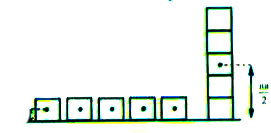n identical cubes each of amss m an side I are on the horizontal surface. Then the minimum amount of work done to arrange then one on the ther is Solution in Telugu
nmmgl
mgln22
mgln(n−1)2
mgln(n+1)2
The correct Answer is:C
Step by step video, text & image solution for n identical cubes each of amss m an side I are on the horizontal surface. Then the minimum amount of work done to arrange then one on the ther is by Physics experts to help you in doubts & scoring excellent marks in Class 11 exams.
Updated on:21/07/2023Topper's Solved these Questions
- WORK -POWER-ENERGYBOOK - AAKASH SERIESCHAPTER - WORK -POWER-ENERGYEXERCISE - PRACTICE SHEET (EXERCISE-IV POTENTIAL ENERGY) (LEVEL -II STRAIGHT OBJECTIVE TYPE QUESTIONS)
2 Videos
- WORK -POWER-ENERGYBOOK - AAKASH SERIESCHAPTER - WORK -POWER-ENERGYEXERCISE - PRACTICE SHEET (EXERCISE-IV POTENTIAL ENERGY) (LEVEL -II MORE THAN ONE CORRECT ANSWER TYPE QUESTIONS)
2 Videos
- WORK -POWER-ENERGYBOOK - AAKASH SERIESCHAPTER - WORK -POWER-ENERGYEXERCISE - PRACTICE SHEET (EXERCISE-III CONSERVATIVE AND NON CONSERVATIVE FORCES) (LEVEL -II MORE THAN ONE CORRECT ANSWER TYPE QUESTIONS)
11 Videos
- VISCOSITY BOOK - AAKASH SERIESCHAPTER - VISCOSITY EXERCISE - Questions for Descriptive Answers
3 Videos
- WORK POWER ENERGYBOOK - AAKASH SERIESCHAPTER - WORK POWER ENERGYEXERCISE - EXERCISE - 3
61 Videos
Similar Questions
The system shown in figure is released from rest. String is massless, and pulley is smooth. Find work done by gravity on 4kg block and workdone by the string on 1 kg block in 2 seconds?

View SolutionA Particle slides down a frictionless parabolic (y=x20 track (A→B→C) starting from rest at a point A as shown in fig. Point B is at the vertex of the parabola and point C is at a height less than that of point. A. After C, the particle moves freely in air as projectile. If the particle reaches heightest point at P, then which of the following are not correct.

View SolutionA particle of mass 1 kg is moving along x-axis. It's velocity is 6m/sec at x=0. Acceleration (a), displace (x) curve and potential energy (u) -displacement (x) curve of the particle are shown.

View SolutionAn iron sphere of mass 20×10−3 kg falls through a viscous liquid with terminal velocity 0.5 m/sec. Find the terminal velocity of another iron sphere of mass 54×10−2 kg.
View SolutionIf →A+→B=→Rand2→A+→B is perpendicular to →B then
View Solutionn' identical cubes each of mass 'm' and edge 'L' are on a floor. If the cubes are to be arranged one over the other in a vertical stack, the work to be done is
View SolutionWhat is the amount of work done in bringing a mass from the surface of Earth on one side to a point diametrically opposite on the other side?
View SolutionEach side of a cube is measured to be 7.203 m. What is total surface area?
View SolutionIdentical cubes each of mass 'm' and side T' are on the horizontal surface.Then the minimum amount of work done to arrange them one on the other is
View SolutionIf n number of identical cubes, each of mass m and side a lying on level ground. Find the work done in piling them one above the other.
View SolutionTwenty identical cubical blocks each of mass 100 gm and of side 10 cm are lying on a horizontal surface. Work done in piling them one above the other (g=10ms^(-2))
View SolutionConsider ..n.. number of indentical cubes each of mass ..m.. and side ..a.. lying on a level ground. Find the work done in piling them one above the other.

View Solutionn identical cubes each of mass .m. and side .l. are on the horizontal surface. Then the minimum amount of work done to arrange them one on the other is
View SolutionTwenty identical cubical blocks each of mass 100 gm and of side 10 cm are lying on a horizontal surface. Work done in pilling them one above the other is, (g=10 ms^(-2))
View SolutionTwenty identical cubical blocks each of mass 100 gm and of side 10cm are lying on a horizontal surface. Work done in piling them one above the other is, (g=10ms−2)
View Solution
